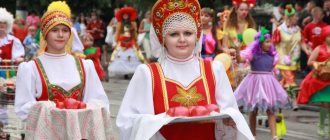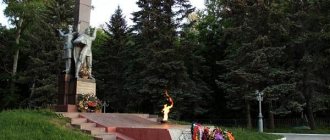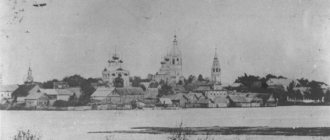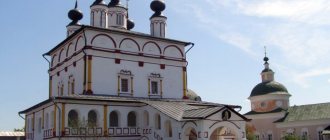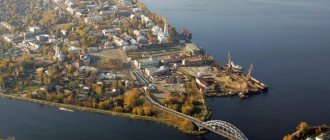The small provincial town of Tutaev (Romanov-Borisoglebsk) in the Yaroslavl region is included in the Golden Ring of Russia. It is famous for its miraculous icons, picturesque landscapes, and museums. A special place formed along the Volga is famous for the presence of a large number of cultural heritage monuments. Interestingly, the banks of the river are not connected to each other by a bridge.
The settlement is divided into two sides - Romanovskaya and Borisoglebskaya. They are connected by ferry, the schedule of which must be clarified before the trip. In winter, you can get to the other shore on ice. You can also take a detour by car. You will need to cover about 40 kilometers one way. Tutaev is famous due to the abundance of ancient temples of the 18th century.
The streets are cozy, and at every corner you will find an interesting object worthy of attention. First of all, take a walk in the center, there are streets such as Ave. 50th anniversary of the Victory, Proletarskaya, Komsomolskaya. To avoid getting lost, use a map with house numbers.
Tutaev City Day is celebrated on August 4. Many people ask how old the city is. It recently celebrated its 735th anniversary. The city day program is always intense, artists come and fairs are organized. The population happily welcomes guests, tourism is thriving.
Where is Tutaev
The city is located on the western slope of the Danilovskaya Upland. It stands on the federal highway between Yaroslavl and Rybinsk. Using the highway, you can get to the city by car or by bus - 300 km from Moscow. There are two bus stations in the city, operating around the clock: on the right bank on 50th Anniversary of Victory Avenue, 34/57; on the left - st. Panina, 54.
There is no railway passenger station in Tutaev, so it takes 4 hours from Moscow to get to the Yaroslavl-Glavny station by train, and then travel another 1 hour by minibus.
The nearest airport "Tunosta" is in Yaroslavl, 35 km away. Airplanes from Moscow and St. Petersburg are received here. During the navigation period, a motor ship leaves Yaroslavl every day. It moored in the Borisoglebsk part of the city, and stays there for one minute.
There is no bridge across the Volga in the city. Communication between parts of the city occurs on the ice of the river in winter, and on water by ferry in summer. The nearest bridge is in Yaroslavl. Movement within the settlement on both sides is serviced by taxi companies.
How to get there?
regularly conducts trips to the cities of the Golden Ring of Russia.
Travel from Kazan
Travel from Cheboksary
Travel from Yoshkar-Ola
The Tutaev Culture and Tourism Center (Romanov-Borisoglebsk) is in demand among vacationers. You can come here on your own or choose a thematic excursion. An experienced guide will tell you many interesting historical facts and reveal the secrets of historical events of antiquity. Hiking is popular. This type of leisure is chosen by those who value a calm and peaceful atmosphere. The local landscapes are beautiful, there is a lot of vegetation and plantings.
You can get to Tutaev using a comfortable bus. Dispatch is made from the Shchelkovo bus station. The drive will take 6-6.5 hours. Check the Yaroslavl-Tutaev bus schedule in advance. If you need a faster option, you can use a personal car. Driving along the M-8 highway.
Weather in Tutaev, best time to travel
Tutaev opens its sights best in the summer months. At this time, ferry and private boats freely transport tourists from one part of the city to another. The bright greenery of the alleys and parks, swimming in the Volga will bring pleasure and cool you down from the heat. The average thermometer reading is +18.2˚С, at the peak of summer in July +23-25˚С. Warm rains fall regularly.
Golden September is a good time for an excursion, but the autumn months will close the crossing and bring down rain and dampness on guests. The temperature is not very low, from +4 to -2˚С. Spring takes a long time to arrive, only at the end of May nature, the crossing and the time for excursions come to life.
In winter, even in Epiphany frosts, the thermometer does not drop below -12˚С. A mild, snowy winter with a pedestrian crossing of the Volga, Christmas holidays and a New Year tree encourage fairy tale lovers to visit the Russian hinterland.
| January | −10.1 | May | +11.0 | September | +10.4 |
| February | −9.5 | June | +16.0 | October | +4.4 |
| March | −4.1 | July | +18.2 | November | −2.4 |
| April | +4.0 | August | +16.1 | December | −7.1 |
Religious buildings of Tutaev
The city of Tutaev stretches on both sides of the Volga, and in each part of it many churches and temples have been erected. Ancient, restored, revered and famous churches throughout Russia, reflected in the river, create a picture of a truly Russian Orthodox monastery.
Resurrection Cathedral
On the site of the Cathedral of Boris and Gleb, which had fallen into disrepair, the Resurrection Cathedral was erected in the 17th century. For a long time there was a monastic monastery here. The place is considered holy and prayed for.
A special feature of the cathedral is its constant operation; the temple has never been closed. Church services and ceremonies were held here every week at all times. The temple is operational.
The height of the building is 50 m. Figured masonry decorates the outer walls. Graceful arches of windows, bunches of semi-columns in the walls between the openings decorate the galleries. Decorations with tiles and paintings from biblical scenes in the upper belt complete the decoration of the facades.
The interior decoration has been preserved in its original form. A masterpiece of icon painting is the 15th century icon “The All-Merciful Savior” measuring more than 3 m. The icons of the Mother of God “Hodegetria” and the carved image of St. Nicholas the Wonderworker are considered iconic.
You can pray in the cathedral. People far from faith will admire the beauty of the architecture, decoration, painting, and iconostasis. The cathedral is located on the Borisoglebskaya side of the city, on Sobornaya Street, 13A.
Holy Cross Cathedral
The cathedral was built in the Romanov part of the city in 1658, instead of the old wooden Romanov church. The location is surrounded by natural ramparts, ravines, a man-made hill and a ditch.
The building is made of stone, with five domes on towering necks. The bell tower and both limits have hipped roofs. The temple is illuminated by windows on the upper tier and symbolizes the heavenly light of Christ; the twilight below does not distract believers from prayer.
Russian tsars took part in the construction and arrangement of the cathedral: Mikhail Fedorovich donated the icon of the Tikhvin Mother of God, and his son Alexei Mikhailovich allocated 100 rubles from the treasury. and establish payments to the clergy in government money.
The rich interior painting belongs to the early North Russian school of painting. The biblical episode of the beating of Christ is interesting: the executioners are not Roman warriors, but Russian men. The paintings “Ecumenical Assemblies”, “Apocalypse”, “Tree of Jesus” on the western side of the cathedral are well preserved.
In the temple, the icons “Svensk Icon of the Mother of God”, which is believed to heal people from drunkenness, and the image of the Passion of the Lord with 72 particles of the relics of unknown saints, are venerated.
Between 1930 and 1992 the temple was closed. It is now operational and services are held there. The location of the temple is the street named in his honor: Krestovozdvizhenskaya, house 47A.
Annunciation Church
On the high right bank along Blagoveshchenskaya Street, house 11A, the Annunciation Church is located. It was built by Moscow architects in 1660. A small square building measuring 11x11 m, there are no supporting columns inside, the ceiling and vaults rest only on load-bearing walls, 1.3 m thick. The closure of the temple occurred in 1929, and only in 2001 it was returned to the fold of the church.
Restoration work is still underway. A dome, bells, and iconostasis were installed. There is a return of the lost images of the Kazan Mother of God, Peter and Paul from 1885, a full-length image of St. Nicholas. Believers and guests replenish the iconographic fund with their donations and holy images.
Before its closure, a particularly revered savior, the Don Icon of the Blessed Virgin Mary, was kept in the church. Thanks to the power of intercession, she protected the inhabitants from a pestilence in 1771 and gained fame as a miracle worker. Subsequently, it was transferred for storage to the Resurrection Cathedral.
Kazan Transfiguration Church
Tutaev opens the sights of cathedral buildings for viewing on both sides of the Volga. In the Romanovskaya part of the city there is the Kazan Transfiguration Church, built in 1758. The temple is shrouded in a number of beautiful legends.
Traditions say that when the Kazan Icon of the Mother of God was in Romanov, miracles and healings of the sick happened in the city. To obtain the holy image, the townspeople needed to build a church, but they did not have time. During the Time of Troubles, the face came to the Poles, and then to Yaroslavl.
People came to their senses and began building the temple - the red sun. The church is five-domed, made of red stone. In the distance, one step higher, there is a bell tower. The beautiful church was built, but too late, and no force could bring back the Kazan Icon of the Mother of God; it remained in Yaroslavl. Every year on the patronal feast day the icon is brought to the city for a religious procession.
From 1931 to 1997 the church was closed; the first wedding ceremony was held in 1999. Shrine location address: st. Volzhskaya Embankment, building 25.
Sights of the Romanovskaya side, left bank
The oldest architectural monument of the city is the Cathedral of the Exaltation of the Cross . It represents the beginning of the entire history of the settlement. Once upon a time, the white stone church was made entirely of wood. At this place there was a temple in the name of the Exaltation of the Holy Cross. The shrine was located on a hilly area, surrounded by steep slopes of the coast.
In 1658, it was decided to erect a new building. Metropolitan Ion Sysoevich took an active part in this process. The painting of the porch was done with the participation of Kostroma icon painters and Russian artists. Today, the 18th century frescoes are in poor condition and require restoration. A large proportion of the shrines have already been lost, the remaining ones are also under threat. Every guest can visit the holy place. Divine services are held regularly.
If you walk further along the ornate road, you will see the Zatsepin estate . The 19th-century building currently serves as a museum. There is a sheepfold and a small hotel here. Those who want to take a break from the bustle of the city often come here.
Also nearby you can see the Transfiguration-Kazan Church . It is distinguished by a large hipped bell tower equipped with eight sides. This is a beautiful building that serves as the face of the ancient town. The building, built in 1758, previously stood near merchant ships. It decorated the main state entrance. In the building itself you will see two churches. In the lower part there is the Kazan Church, and in the upper part there is the Transfiguration Church.
A small mansion has recently appeared behind the shrine. There is a museum here called “House on Novinskaya” . Most of the exhibition halls are dedicated to the history of the development of the provincial bank. There are old safes, counting instruments and much more on display. There is even an entire room, the interior of which copies a traditional banker’s apartment. There is a special, mysterious atmosphere around. Ticket price – 150 rubles.
The road then leads to a square with a 19th-century fire tower . If you have watched Leonid Gaidai’s film “The Twelve Chairs,” you will certainly recognize her. Guests of the province mainly come to the square to get acquainted with the Stroganov salt warehouses. This object has the status of federal significance.
The Church of the Archangel of the Savior stands modestly and a little far from the rest . Its condition is deplorable, the walls are dilapidated, the plaster is crumbling. Surprisingly, this temple used to be very rich. Quite famous people liked to visit him. The situation changed when the monastery was transferred to fellow believers. This happened in 1855.
Church of the Intercession was built in 1654. It was once part of a monastery. Her work continued even during the Soviet period. The main value is the local icon made on canvas. The bell tower is quite high. It is decorated with antique, monochrome tiles.
While relaxing in Tutaev, you will be able to fully relax and learn a lot of interesting information about the amazing Russian corner. The seemingly inconspicuous settlement contains a centuries-old story about the life of its ancestors. The most beautiful can be called Ushakova Street . You will find it on the left coast. It is here that most of the wealthy merchant buildings of the 19th millennium are concentrated. Among them, the house of the Illarionovs and Apakhovs . These are architectural monuments.
Italian bridge nearby . It performs a pedestrian function and is made directly above the ravine. Another beautiful place is Lenin Square . It still retains the spirit of the market place. Here you can find souvenir shops, merchant shops, and Demidov's tavern . If you climb to the highest point of the fire tower, you will see a dizzying panorama of the surrounding area. The whole town opens up as if in the palm of your hand.
On Polevaya Street there are echoes of an ancient cemetery. You can see ancient crypts and tombstones. They were preserved in a grove of birches. At the end of your trip, don’t forget to stop by the souvenir shop. Popular items include magnets, crafts, landmark boxes, and more.
Springs, recreation centers
In the suburb of Tutaev, many springs also formed. There is a “Holy Spring” on the Kovat River. In the village of Velikoye, the “Spring of Beauty” broke through, near the Edom River, near the Lesnoye rest house, and near the village of Martynovo, underground waters found a natural outlet to the surface.
Sources of holy places are in high demand. So, four kilometers from the city there is the famous key of the Savior . A spring well was built here.
The source of St. Nicholas the Wonderworker is also known in the settlement for its life-giving power.
Outside the city you will find many places where you can have a great time. Popular are the hunting club “Cardinal”, recreation points “Myshkino Podvorye”, “Europe”, “Demino”. The complexes employ friendly service personnel. You can ride catamarans, go fishing, water skiing, and visit sandy beaches. And in winter, skiing, skating, and sledding are popular. Walk around the area, you can get great pleasure from the beautiful nature and clean air.
Tutaev Museums
Unusual museums with their own traditions and cultural values will delight tourists in the city. Exhibition displays introduce the original way of life, stories, and nature.
Museum "Borisoglebskaya side"
The museum and exhibition complex occupies the second floor of a local school at 40A Lunacharsky Street. Exhibits of various subjects are collected here. The founder of the museum was the exhibition “The Royal Sheep”.
The exhibition presents the way of life of a wealthy peasant family. A bed, dishes, benches, homespun rugs, wooden utensils, images in the front corner - the simple and most necessary utensils of a residential house. You can see outlandish Romanov laces and nails - brands from a distant fatherland.
Before the revolution, a manufactory for processing flax of the German emigrant Yegor Egorovich Klassen operated in the city. In the exhibition dedicated to him you can see details of mechanisms and machine tools, photographs of people working and managing the factory. A part of a merchant class apartment has been restored.
The next room is a classroom in an ordinary Soviet school. Wooden desks with hinged lids, sleeves, and inkwells. Above the board is a portrait of the leader, with chalk on the side. On the cabinet there are models from the beginning of the last century, a globe, stuffed birds.
Another exposition of a Soviet apartment of an ordinary family of that time, an official’s office, a “district store” - a store of regional significance with goods and labels from the last century.
The fauna is represented by 200 exhibits of the Volga forests. The exhibition “Kustodievskaya Tea Room” reveals the trading life of the early 20th century. Such establishments were built around market squares. An exhibition of documents, photographs, letters telling about participants in the First World War, the Patriotic War, and the Civil War is dedicated to the memory of our fellow countrymen.
The museum is open 6 days a week, except Mondays, an adult entrance ticket costs 150 rubles, a child 100 rubles. Duration of the excursion is 1 hour 15 minutes.
Museum "House on Novinskaya"
In the 19th century, the building was given over to the provincial bank of the Russian Empire. Today it is the only museum of this type in Russia. There are two expositions on display in the spirit of the early 20th century: a bank branch on the ground floor, and a manager’s apartment on the second and third floors.
The operating room is equipped with original safes and natural furniture of those times. Bank notes from the last century attract special attention.
The atmosphere of an apartment belonging to a bank manager is reproduced. The museum workers have introduced an interesting tradition: the decor in the house corresponds to the time of year outside the window. Clothing exhibits, menus of displayed dishes, bouquets of flowers or autumn leaves, and a New Year tree change.
Additional exhibitions tell about people's entrepreneurial activities, their income, and, consequently, profit for the bank. The museum is located on Lenin Street, 52, ticket price is 100 rubles, photography is paid.
Museum of Admiral Ushakov and the Russian Fleet
Russian admiral Fedor Fedorovich Ushakov was born in the village of Burnakovo, which today is located within the Romanovskaya part of the city. The purpose of opening the museum in 2012 was to perpetuate the memory of the Russian officer, warrior and recognized saint Fyodor Ushakov.
The museum building at 43 Lunacharsky Street is not directly connected with the name of the admiral; it previously housed the police and fire department. There are two exhibition displays. The first tells about the life and exploits of Ushakov, the second talks about the formation and traditions of the Russian fleet. The excursion lasts 45 minutes and costs 100 rubles. for an adult, 70 rub. - for children.
House of the merchant Vagina
In the historical part of the city, on the right bank, in the middle of the 19th century, a building appeared that belonged to the merchant Vagin. The building has not changed since then, either inside or outside. Now there is a museum in the merchant mansion, where you can learn about how they lived in those days, what floors, stoves, and utensils were like, that is, you can plunge into the real merchant atmosphere of the past. The museum is located on Lunacharsky Street, 38/25. A visit with a guide costs 330 rubles, an independent inspection of the exhibition costs 45 rubles.
Monuments in Tutaev
The memory of significant events, famous people of the city and country is immortalized in monuments, sculptures, and memorial complexes of Tutaev. The works of individual sculptors are interesting, as a work of art.
Monument to I. Tutaev
The man whose name the city bears was a young Red Army soldier who died during the Civil War at the hands of the White Guards. In 1957, a bust of the young hero was installed in the city park. The author of the monument is the Yaroslavl sculptor A. Solovyov.
Bust-monument to Marshal F. I. Tolbukhin
Fedor Ivanovich Tolbukhin, a native of the village. Androniki, Romanovo-Borisoglebsk district. He took direct part in the fighting for Stalingrad and commanded the troops of the 3rd and 4th Ukrainian Fronts. The Marshal was awarded many orders and medals, he is a Hero of the Soviet Union. In 2001, in his homeland in the city of Tutaev, a bust of the hero was installed on Yubileinaya Square.
The sculpture was made by Bulgarian citizens Mara Georgieva, Ilia Iliev. Initially, it was installed on the square of Sofia, the capital of Bulgaria, in memory of the leader of the operation to liberate the city from the Nazis.
Over time, the Bulgarian authorities changed their opinion about the liberators and decided to dismantle and destroy the bust of the hero. Through the efforts of journalists and diplomats, the monument was transferred to Russia and installed in the marshal’s homeland.
Behind the monument to F.I. Tolbukhin, an alley has been laid out, along which busts of Heroes of the Union and Russia who performed military exploits are installed. There are 11 military memorial buildings on the territory of the city.
Don't miss the most popular article in the section: Metro Nizhny Novgorod. Diagram, map, description.
Monument to Admiral F.F. Ushakov
The monument to the great naval commander F.F. Ushakov is located on the left bank of Tutaev, at the intersection of Krestovozdvizhenskaya and Panin streets. The sculptor is Vsevolod Romanovich Alaev, the bust was made at the city bell factory with donations from residents and the Russian Traditions Foundation. The monument is a tall stele, in front of which there is a bust of F.F. Ushakov on a ledge.
Girl with a scarf
An unusual sculpture from the Soviet period is installed in the city park. This is a girl with a scarf in her hands, carefreely walking along the alley.
In addition to her, in the park there is a sculpture of a girl with a basket and a monumental bust of Karl Marx.
Kazan Transfiguration Church
This is another ancient shrine of Tutaev. The temple was erected in 1758. This is a five-domed structure made of red stone. In 1931, instead of a church, the building housed the district executive committee; later there was a brewery, an oil mill, and was even used for housing.
After the collapse of the Soviet Union, the church was restored. During the work, it was even possible to discover a cemetery that was under the church itself.
The temple is located on Volzhskaya embankment street, 25.
Architectural structures in Tutaev
Tutaev presents the architects' sights with two types of architecture: a new city with modern buildings and an old one: reverent, preserving a special style of buildings and life. Tourist sightseeing tours around Tutaev will definitely lead to architectural structures.
Fire Tower
The famous Tutaevskaya fire tower was filmed in the film “The Twelve Chairs” directed by Gaidai. This is an architectural monument of federal significance of the 20th century. The tower is adjacent to the fire station and is located on Market Square. The height of the building is 25 m, 4 floors, made of stone, wooden superstructure.
On the tower there is an observation deck accessible to tourists. From above you can see beautiful views of the city and the expanse of the Volga. In 2018, architectural façade lighting was introduced. This made it possible to admire the construction in the evening, at night, and for amateur photographers to take wonderful pictures. The cost of viewing the city from the observation deck is 100 rubles. on weekdays, 150 rub. - on weekends.
Museum-Estate of the Zatsepin Nobles
The residential house of the Zatsepin nobles is designed in the typical architectural style of the 19th century. The estate is located on the Romanovskaya side of the city on Krestovozdvizhenskaya street, house 45. A high stone foundation is built under the house, the facade is decorated with a portico on wooden columns. There are linden alleys all around - a mandatory attribute of a noble estate.
The estate of the leader of the local nobility Mikhail Zatsepin appeared in Tutaev at the beginning of the 19th century
The building belonged to the Zatsepin family; during the First World War there was a hospital in it; in Soviet times there was a music school, a club, and apartments for living.
Currently it is a private property, used as a museum of the life of the nobility and a hotel at the same time. Here you can simply visit on a tour, or live in the atmosphere of past centuries, and feel like a special person of noble rank.
Near the house there is a small building where a couple of sheep of the famous Romanov breed live. There is a flower garden in front of the house.
Flyaginsky Bridge
In the 19th century, the Medveditsa River flowed through the city. The banks are connected by a three-arched Italian-style bridge. The author of the structure is S.N. Grechaninov. The bridge abutments end with pilasters, the lower ones are expanded with braces. The bridge fastenings are connected by forged metal. The building is made of red brick. This is a very unusual and lyrical structure of the city.
The bridge has a number of other names: old viaduct, Leontievsky bridge, Flyagin bridge. They say that the construction of the bridge was initiated by a wealthy landowner from St. Petersburg, Flyagin.
Currently, the viaduct does not fulfill its intended purpose: the river has become shallow, all that remains is a stream. The architectural structure is often visited by newlyweds, where their first family photo session takes place, and by numerous tourists.
Church of Tikhon of Amafuntsky
On Tolbukhin Street in the depths, you can see a small temple. It was erected in 1914, from red brick according to the design of M. Barenkin. This is an Old Believer church on the 1st floor, with large window openings. The bell tower of the church is tent-shaped.
In 1936, the temple was closed and an archive was placed in it, which is why the building is so well preserved.
Natural attractions of Tutaev
The nature of the Tutaevsky region is quite diverse. Natural groves and man-made parks are favorite vacation spots for city residents. The main attraction is the Volga River. Guests of the city will be interested in visiting popular places of natural origin.
Spring of St. Nicholas the Wonderworker
There is a mineral spring on Yaroslavskaya Street, which is very rare in Tutaev. The history of its origin is unknown, but local residents firmly believe in its healing and holy powers. The chemical composition of the water indicates medium mineralization, hardness, and an increased content of bacteria. Organoleptic qualities are good.
On the Orthodox holiday of Epiphany on January 19, a service and lighting of the water are held near the source. Many people gather for the prayer service, but there is no access to the source, so you have to walk. A visit to the spring is included in the city tour.
City Park
A favorite vacation spot for townspeople is the Soviet period park on Romanovskaya Street, 16. It preserves and reproduces the atmosphere of life of the socialist period.
Alleys with benches for rest, sculptures typical of that period: a boy with a bugle, a girl in a pioneer tie; busts of Soviet writers: Gorky M.A., Mayakovsky V.V. An attraction of the park is an exhibition of old cars. There are not many of them, but they are all well maintained and restored. Visiting the park is free.
Swimming areas
Summer time involves relaxing on the water. There are many beaches in the city where you can relax: free and for money. Comfortable rest will be provided by recreation areas with changing rooms, showers, and sun loungers.
It is better to spend free time with children in places where there are special fenced areas with a shallow, cleared bottom. Pontoon pools with filtered water are also recommended. There is a good service for the sale of soft drinks and food on the beaches.
Spaso-Arkhangelsk Church
At 4 Arkhangelskaya Street, the oldest temple in the city has been preserved. This is a two-story, five-domed building.
It was erected back in 1751. Initially, the church had a name - Mikhailo-Arkhangelskaya, but the temple received its modern name in 1854 and so it stuck with it.
A huge icon of the Savior has been preserved in the church. Local residents claim that this work was done by Prilutsky’s student, Dmitry.
Modern objects in Tutaev, interesting to visit
Tutaev attractions produced by the city's artisans include several brands: sheepskin products, bells, kvass. Travel lovers bring memorable souvenirs and things from excursions.
Bell factory
Not far from the city center, on Yaroslavskaya Street, 51/2, there is a factory for the production of bells for churches and temples in Russia, Ukraine, and Kazakhstan. The company is headed by Nikolai Shuvalov. Under his leadership, the casting technology and the secrets of musical ringing were restored. Bells weighing from 1 kg to 8 tons are cast by local craftsmen.
When visiting the enterprise, tourists will be told about the ancient recipe for making bells, the composition of the metal, the reason for burying them in the ground, the use of manure and kvass wort in the production and many other things. You should definitely buy a small copy of the real bell as a souvenir.
Sheepskin products
Breeding the famous Romanov sheep gave rise to the sheepskin and fur trade. The factory is located on the territory of the Tutaevsky district. It produces skins and sews orders for the army and railroad for sewing mittens and short fur coats.
In Tutaev, during a festival dedicated to the Romanov sheep, you can buy interesting products made from animal fur and wool, made by local craftsmen. The goods of the sheepskin and fur factory are sold in the village of Miklyaikha on the street. Kalinina, 30v, 24 km from Tutaev.
Warm mittens, slippers, onuchi, and accessories will keep the warmth and memory of the city on the Volga for a long time. Prices are moderate: slippers – 630 rubles, muff – 1200 rubles, a chic envelope for a baby made of fur – 3800 rubles, short fur coats – 7000 rubles.
A sheep souvenir will be offered as a keepsake at the TutSouvenir store on the street. Motorostroiteley, 72 a, in trading. There is a wide range of gifts here.
Romanovsky kvass
Kvass produced at Romanovsky Product CJSC on the street is famous for its refreshing taste. Romanovskaya, 12a. The recipe has been preserved since ancient times. The drink is based on incomplete alcoholic and lactic acid fermentation of the wort with the addition of 1.2% alcohol for strength. The process requires a lot of labor. The strong, specific taste of kvass is liked by the local population and tourists.
Shopping in Tutaev
The retailer at 53b Motorostroiteley Street will present painted boxes with images of city landmarks, magnets, and key rings. The shopping center has various product departments that provide full service to the retail establishment.
Interesting places to relax with children
It is unlikely that children will get bored in the Ushakov Museum, where they can learn how to tie knots and break a bottle, or they will not like the story about the Romanov sheep, and the ferry across the Volga is a real sea voyage. But at the same time, children can be entertained in a normal play environment.
Relaxation in the park
The city does not have its own water parks; the zoo is only imported. You can spend time in the recreation park on the street. Dementieva. Within the boundaries of the park there are three playgrounds for different age categories.
For children there are swings, trampolines, and slides. Older children spend time on the playground with horizontal bars and soft rubber coating. The third is sports for volleyball and basketball. There is a children's cafe "Serdolik" in the park; sweet products are sold in stalls.
Children's corners in shopping centers
Trading is located in the city center at the address: st. Motorostroiteley, 72A. When going shopping, you can leave your children at the playground, where they frolic, play and have fun.
At 50 Letiya Pobedy Avenue, 10 there is a Family Recreation Center. There are playgrounds for children next to the billiard room and cafe. Dry pool, labyrinths for different age groups. The cost of 1 hour is 100 rubles.
On the street Panina, 54, the people's theater "Left Bank" and the children's exemplary theater "Monday" settled, under the direction of S. Astaeva. You can attend theatrical performances and productions with your child.
Ski holiday
The entire range of winter entertainment is presented in the Nikolina Gora resort complex. Alpine skiing, snowboarding, tubing (cheese sled), skating. Coaches for children are available for vacationers. The service is provided by the presence of a cafe, a bathhouse, snowmobiles, and ski lifts. The cost depends on the number of lifts.
Route for exploring Tutaev on your own for 1 day
There are quite a lot of ancient churches, temples, unusual museums and attractions in Tutaev. The area of the city itself is small; excursion sites are concentrated in close proximity to each other. One day is enough for a sightseeing tour of the pearl of the Volga expanses, the city of Tutaev.
- The beginning of the excursion will be determined by the “main traffic light” (local residents will point to it). Walking along the street We will see engine builders at the Serdolik cafe. Let's get to the street. Cathedral.
- You can visit the Resurrection Cathedral. Behind the temple, going down the steps, we move to the embankment, with a bewitching view of the Volga.
- Using a motor boat or ferry, we will cross to the opposite bank of the city, while admiring the scenery of the river.
- From the pier there are views of baptized Rus': the Church of the Kazan Icon of the Mother of God, the Church of the Transfiguration, the Church of St. Tikhon.
- A walk along the quiet streets will lead you to the center. Tourists will see a sculpture of the leader of the proletariat V.I. Lenin, Bank, exhibitions “Romanov’s sheep”, “Romanov’s bagels”, “Romanov’s nail”.
- There is also a fire tower here. Using the observation deck, you can see the entire city from above.
- Moving along the street. Ushakov we go to the Holy Cross Cathedral and Leontief Church. Let's admire the Leontief Bridge.
- On this route we get to the Museum-Estate of the Zatsepin nobles, the adjacent park.
- Further along the street. Ushakov we go to the Church of the Intercession, the Church of the Archangel of the Savior.
- Having crossed the ravine, we will find ourselves near the Church of the Life-Giving Trinity.
- Let's return to the right side of the city, rest at the crossing and enter the Park of the Soviet Period, examine the exhibits of vintage cars.
- Having passed through the Yubileinaya square, we find ourselves on the Alley of Heroes and go to the Tolbukhin monument.
- And another Church of the Annunciation of the Blessed Virgin Mary, and not far away the new Church of Benjamin.
Brief history
The settlement did not always bear this name. Tutaev (Romanov-Borisoglebsk) was renamed not by chance. Previously, two completely different settlements were actively developing here. Romanov was on the left bank, and Borisoglebsk was on the right. The foundation of the right bank district is associated with the name - Roman Vasilyevich. It was a defensive fortress from the 18th century. Soon another hail appeared on the opposite bank. It acted as a fishing settlement. In 1822, a decision was made to unite the settlements. Alexander I did this for economic reasons.
In 1918, a new government came and wanted to change the name. Many options have been proposed. But I liked the name “Tutaev” more than the others. It has been established for a long time and remains unchanged for hundreds of years. From time to time the question of returning the historical name arose, but no one supported it. In the old days the city had a hilly “Swiss landscape”. Unfortunately, most of the churches with golden crosses have been destroyed. Many objects are under restoration.
Hotels in Tutaev
Not everyone is comfortable with a one-day sightseeing tour. Someone wants to visit holy places, attend services, walk through museum exhibitions, and visit the noble estate of the Zatsepins.
Accommodation and accommodation can be found:
- at the Imperium Hotel at st. Rosa Luxemburg, 44. The cost of a double room is 1500 rubles, there is a restaurant;
- hotel "Volzhskie Prostori" on the street. Yaroslavskaya, 36a has budget places, the cost of a single suite is 1300 rubles;
- on the left side of the city you can rent rooms for 2, 3, 4 people in the Romanovo creative house. Here, upon request, three meals a day and bath services will be provided. You can spend a romantic time in the living room by the fireplace and listen to the piano. You can find out the cost and book a room by calling or 8 (48533) 7 34 22;
- you can rent a room for two at Pokrovskaya Square, 8. The price in the season is 2500 rubles, at other times 2000 rubles;
- using the services of the private sector, the daily cost will cost from 1,000 rubles. in a day. Addresses can be found on the city's website;
- Yaroslavl, located 34 km away, provides many options for accommodation.
Church of the Intercession of the Virgin Mary
This is a small white stone church, which until 1771 was a monastery. The exact date of construction of the structure could not be established. The building is one-story, built of white stone, with thick walls and low arches. The bell tower in the church is tall and tent-shaped.
Despite the persecution of believers during Soviet times, services in the temple did not stop.
A rare icon of the Mother of God “Addition of Mind” has been preserved in the church. On the porch, frescoes of old writing are partially preserved. And on the right side of the porch there is a grave preserved, whose grave it has never been identified.
Address: st. Krestovozdvizhenskaya, 45.
Where to eat in Tutaev
Guests of the city will not go hungry, but the restaurant service is modest:
- cozy restaurant "Myasnoy Dvor", address: 50th Anniversary of Victory Avenue, 20A. Tel.. Dinner for two will cost 900 rubles;
- inexpensive cafe "Serdolik" on the street. Sobornaya, 40, set hearty lunch for 250 rubles. Tel.: 8-485-332-22-42. Opening hours: Mon-Fri – 12:00-23:00; Sat, Sun — 12:00-01:00, but during events the cafe is closed;
- coffee shop "Teplo" on the street. Motorostroiteley, 62. Open: Mon-Fri - from 09:00 to 23:00; Sat-Sun—from 10:00 to 23:00. Tel.: +7;
- “Chaynaya” (on Sobornaya, 18/62) is open from 09:00 to 19:00. Hot food, baked goods, and tea will be provided here;
- reputable restaurant "Sorrento" on the street. Tereshkova, 1. Before visiting, you should find out about availability by phone..
How to get around Tutaev
Moving within the city involves various types of transport. A water ferry will cost 27 rubles. for adults and 13 rub. for children. His work during the navigation period begins at 6.00 and ends at 22.30. Cargo transportation is assessed additionally. Our own on the water, that is, motor boats at a price of 30 rubles. per person.
Land transport can be pedestrian or taxi. Each part of the city is served by two carrier companies around the clock. On the left bank you can use the services by calling: (48533) 7-35-00; 8-905-630-30-11 or +7(905) 635-07-07.
The right bank is served by companies with telephone numbers: +7 (48533) 7-00-00; or +7 (48533) 2-14-15, +7 (905) 131-05-20, +7 (48533) 2-03-35. The cost of the service is 70 rubles. — up to 3 km, further 12 rubles. for 1 km. Waiting time 1 min - 5 rub.
An unusual and interesting city. Bright and clean from numerous churches and prayers of holy people. Apart from modern buildings, the city can be attributed to the patriarchal style of architecture.
The tranquility is not disturbed by the noise of public transport - there is simply none, only a taxi fleet. Walking tours are a lot of fun and satisfaction. Silence, the measured passage of time, the great Volga River, monuments of baptized Rus' - these are the main impressions from visiting the city of Tutaev and reviewing its sights.
Author: Marie Arkhipova
Article design: Mila Friedan

